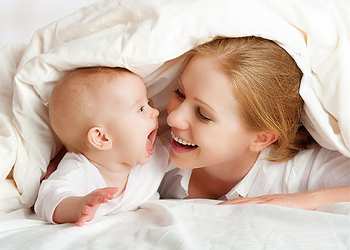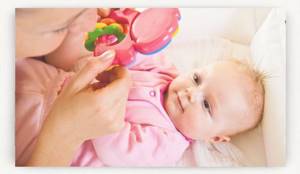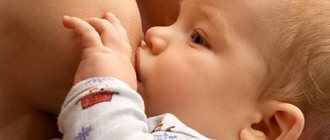The child does not indulge - for him the breast is not only food, but also a means of communication with you)
Your weight is also fine. The minimum increase in the first three months of a child’s life on breastfeeding is 115 grams per week, or 460 grams per month. In the period from 4-6 months, children on breastfeeding gain 400-600 grams per month. In the second half of the year, the increases become even smaller: at 6-9 months - 300-500 g, and after 9, when many begin to walk, it is quite common to add 100-300 g per month.
And if you feed your child on demand, then the child is definitely well-fed and receives a sufficient amount of milk. To understand whether there is enough milk and whether the child is getting enough, do a wet diaper test - if the child pees more than 10 times a day (the norm is 12 or more), his urine is light, transparent, odorless, it means he is receiving a sufficient amount of milk
At what age does a baby develop real laughter?
The newborn baby's contact with the outside world manifests itself in the form of a cry. In this way, the baby shows what he wants to eat, wet diapers irritate him and his tummy hurts. The child’s boisterous laughter becomes a great happiness for the mother. The baby laughs when breathing normalizes, the vocal cords perform functions, and the facial muscles contract.
At 8-12 weeks, the baby can already walk and hear sounds that seem funny to him, and by 3-4 months the baby is laughing. The baby will not smile and laugh if:
- Lying in wet diapers.
- Feels hungry.
- Feels pain and discomfort.
Six-month-old children, having accumulated a lot of emotions during the day, often laugh in their sleep, but over time this passes. Don’t worry when your baby hiccups after laughing, because the diaphragm and respiratory organs are still developing.
What do happy emotions mean?
The baby is born screaming, and by crying he shows that he wants to eat, that he is uncomfortable lying in wet diapers. The baby does not yet know how to talk about discomfort and hunger in another way. But time passes, and the child’s face breaks into a smile when the baby hears:
- mother's tender words;
- funny poem;
- cat meowing;
- bird chirping.
Pleasant sensations and joy in a child are caused by stroking the back or tummy, tickling, or blowing a kiss. Although a baby who is barely a month old does not understand everything yet and does not know how to listen carefully, a beautiful melody or gentle sounds have a beneficial effect on his psychological state.
The appearance of a reaction to the environment is the reason why children smile. Positive emotions arise when the baby already recognizes its mother and focuses its gaze on other people and objects. In order for a baby to laugh and be happy, he needs to be taught this.
Smile as a means of communication
From the second month of life, the baby sleeps less and is awake more. The baby shows his first emotions only by screaming, but when a connection arises between the child and the mother, looking into her eyes, the baby begins to smile consciously, wave his arms, and move his legs. The child changes his behavior to attract the attention of a loved one. Proper communication with the baby accelerates its development, the baby grows cheerful and active.
Laughter as a system of signals and signs
The sooner the mother is able to establish contact with the child, the faster the baby will develop positive emotions.
Children at the orphanage do not smile for a long time because they lack communication with the person closest to them. With laughter, a child reacts to gentle words, a cheerful song, and to his roaring.
A falling leaf, a flying feather, or any bright object that he has not seen before can cause a baby to laugh. With the help of laughter, a child expresses joy and learns sounds.
How do emotions give birth to words?
Its first manifestations should begin at 2 months. Initially, the baby makes separate sounds: “a-a” and “oo-oo”. Gradually they turn into syllables like “da-da”, “aa-gu”, which, in fact, is called humming. Doctors define them as vocalizations.
Experiencing joyful emotions from communicating with adults, the baby involuntarily begins to add cooing to his smile. Having uttered a sound for the first time, the child “tastes” it, cooing to himself. As he grows up, he tries to reproduce other sounds he has heard.
Positive emotions, walking, speech - this is an unbreakable chain that characterizes the normal development of the psyche of a small person. The participation of parents who are able to give their treasure a lot of positive emotions is invaluable. It would seem that it’s just a pleasant conversation, a warm smile, and the baby undergoes a very complex process of turning into a real person.
rated 5.00 out of 5)Loading…
DETAILS: There is protein in the urine: 10 reasons, urine analysis, increased protein in a child, in pregnant women
How to speed up the appearance
Lack of communication with the mother negatively affects the baby’s mental development. Positive emotions in the baby arise later and are less pronounced. In order to make your baby smile faster, you need to pick him up more often, talk affectionately, and you shouldn’t take out a bad mood on the baby. Although the baby does not understand the meaning of the narrated rhyme, he receives positive emotions.
Learning to Smile Consciously
From the second month of life, the baby, hearing a familiar voice, waves its arms, moves its legs, arches its back, then tries to put a bright toy in its mouth. It happens that the baby does not smile for a long time, and then he needs to be taught to show positive emotions.
When taking the baby in your arms, you need to constantly talk to him, show him leaves and toys. Reaching for the flower, the child will laugh with delight.
How to behave to make your baby smile
From birth, the baby needs to be taken care of - fed, bathed, changed diapers. If the baby experiences hunger and discomfort, you should not expect positive emotions. To please your baby with a smile, you can make faces, talk to him more, laugh, then the child will begin to copy his mother’s facial expressions and feel her mood.
Emerging problems and ways to solve them
It happens that up to 3 months the baby does not hold his head up, does not focus his eyes, and does not pay attention to toys. And although no two children are alike, this may signal a developmental delay. In this case, you will need the help of a specialist.
Baby doesn't laugh
If a six-month-old baby begins to smile less and is in no hurry to laugh, young parents often worry. The reasons for this phenomenon include:
- the character and innate characteristics of the baby;
- brain damage;
- delay in emotional development.
The baby does not laugh when the mother rarely smiles, does not express her feelings, is silent and reserved. This problem is present in autistic people, in children who have suffered asphyxia, dropsy of the brain, or hypoxia.
Doesn't smile
If a baby does not show joyful emotions for a long time, doctors advise playing with it more, carrying it in your arms, telling rhymes, turning on music, showing pictures, making faces, and the mother frowning less.
Do you need a pediatrician?
At 8 weeks from birth, babies usually delight loved ones with a smile, if the baby holds his head normally, focuses his eyes on bright toys, recognizes his mother, there are no signs of brain damage, the help of a pediatrician is not required.
From birth, the baby often cries for various reasons. Sometimes young mothers, out of powerlessness, can cry along with their baby. And it seems that the joyful moment of the first smile on your face will never come. But don’t despair, this moment is closer than you can imagine. When a child begins to smile, how can parents not miss this joyful event? We will try to answer this and other questions in our article.
Let's first try to find the answer to the question: why does a newborn smile? At the very beginning of his life, everything happens at the level of innate reflexes
and is completely unrelated to conscious action.
The first smile on your face may appear a few days after birth. This reaction can be observed during sleep, bathing or a fun game.
Why do newborns smile in their sleep? This may indicate their inner peace and satisfaction. Conscious laughter appears 1-2 months after birth in full-term babies. This is due to the development of muscles on the face, the beginning of the work of the part of the brain that is responsible for this process. It is during this period of his life that the baby begins to consciously recognize his family and express his reaction not only in the form of crying, but also with a smile on his face.
The first unconscious smiles
Let's first try to find the answer to the question: why does a newborn smile? At the very beginning of his life, everything happens at the level of innate reflexes and is completely unrelated to conscious action.
The first smile on your face may appear a few days after birth. This reaction can be observed during sleep, bathing or a fun game.
Why do newborns smile in their sleep? This may indicate their inner peace and satisfaction. Conscious laughter appears 1-2 months after birth in full-term babies. This is due to the development of muscles on the face, the beginning of the work of the part of the brain that is responsible for this process. It is during this period of his life that the baby begins to consciously recognize his family and express his reaction not only in the form of crying, but also with a smile on his face.
Complex brain process in the body
This state is a sign of complete calm and tranquility. This can happen during sleep or wakefulness, when the baby is close to a loved one and enjoys it.
Many parents are interested in the question: when does a child begin to consciously smile? To do this, it is necessary for the body to launch important processes, namely:
- development of the corresponding facial muscles and nerves;
- development of the corresponding zone in the brain.
I have been observing children since their birth. When asked by parents when babies begin to coo and smile, I can say for sure that no earlier than 1.5 months after birth. The onset of this moment is individual for everyone.
The main thing is to remember the importance of constant communication between parents and their child.
, because ignoring it can lead to very disastrous consequences.
Often parents do not immediately notice any deviations in the baby’s development and therefore do not seek help. I strongly recommend working with children from birth, and if there is the slightest suspicion, contact qualified specialists.
Smiling is the exact opposite of crying when the child is in an anxious state (he is tormented by pain, anxiety, etc.). We advise you to find out the time norms for the appearance of the first tears in the article.
All reactions are activated by the end of the first month of life, and in the second month they are an integral part of behavior and in order to demonstrate a conscious smile, the baby must reach the age of 2 months after birth.
When a child begins to smile, a complex chain of reactions occurs in his body: with the help of his visual apparatus, he recognizes emotions associated with a certain process (playing with mom or dad, bathing, etc.), then a signal is sent to the part of the brain that responds for relaxing the muscles on the face. This is how the first conscious smile appears.
What can bring a smile to a baby's face?
- playing with mom or another loved one. You can use the game “Ladushki”, the story of a funny nursery rhyme or song;
- as a response to facial expressions of an adult (parents’ grimace) or funny pictures seen.
A new little person comes into this world with a cry, which indicates that the baby has learned to breathe on his own, expanding his lungs to their fullest. Young parents will now observe his crying, whims and grievances daily and repeatedly, because a newborn baby can arrive in two states - discontent and calm. What about expressing positive emotions? But this is what he has to learn!
Physiology and smile
A smile is an involuntary contraction of the facial muscles that does not occur on its own. It is caused by emotions, and most often – positive ones. And emotions, in turn, are caused by a specific reason. It’s not for nothing that they say that laughter for no reason is a sign of a narrow mind. But for newborn babies everything is different. If the baby smiles, showing positive emotions, it means that everything in his development is going according to plan.
It is impossible to describe the chronology of the first smile, because some babies delight their mothers with cute sideways smiles in the first days of life, while others delay these moments for months. But the moment when a child begins to smile, parents always notice. First, a certain grin appears on the child’s face, which wanders and is not addressed to anyone in particular. Psychologists gave this smile the name “reflex” or “physiological.” Of course, at first the child smiles little, and consciousness has nothing to do with these “original smiles.” And only when a smile becomes the result of communication with the baby or an address to him, can it be considered real. It is impossible to say exactly how many days, weeks or months a child begins to smile. Normally, babies who are two months old should already have mastered this skill, causing affection among others. The moment at which age the child smiles is forever imprinted in the parents’ memory, because this is the baby’s first declaration of love for them.
Tiring waiting
But the baby is not always in a hurry to delight with smiles by the 6-8th week of life. Physical activity may interest him much more, and parents never stop looking for reasons why the child does not smile like all his peers. Don’t panic, because teaching a child to smile, as practice shows, is possible! And for this you need to contact him as often as possible. Talk to the baby, stroke him, smile. At a certain point, the baby will understand that you want reciprocity from him and will reward you with a smile. By the way, don’t think that smiling is so easy. To do this, you need to use 17 facial muscles at the same time. If your baby doesn’t smile a month or only smiles reflexively in his sleep, it means he’s not ready for this yet. But this will definitely happen a little later. All attempts to make the baby smile should be carried out not at the time when you consider it necessary, but when the baby is in the mood for it. What is meant? Pay attention to his behavior. If the baby behaves actively, turns his head to the sides, tries to take in everything that is happening around with his eyes, then he is in a good mood. This is also evidenced by walking, attempts to grab onto toys and clothes with fingers.
Alarm Signals
But if the child stopped smiling after mastering this skill, parents should pay attention to this. There may be several reasons:
- lack of attention;
- depression (yes, yes! babies have it too);
- metabolic disorder in the brain.
If the first two reasons can be dealt with quite easily with the help of specialists, then metabolic failure is a serious problem that requires an integrated approach. Fortunately, such violations are extremely rare.
When and why does a newborn start to gurgle and coo?

After all, the baby has been with her from the very moment of his creation. Many young mothers are interested in when newborns begin to coo? This process also occurs approximately 2 months after birth.
This is how the child learns about the world and talks to himself, begins to coo, and pronounces the sounds “a”, “o”, “ya”.
This doesn’t last long, a month after the baby starts cooing, the humming begins
.
If a baby can smile and walk, this means that development and knowledge of the world around him is happening normally. All mothers know that when a baby cries, something is bothering him. For example:
- tummy hurts (read how to help your baby with colic);
- he is tormented by hunger or thirst;
- cold or hot;
- restlessness in sleep;
- wants mom to take her in her arms and caress her.
When a baby smiles, he is calm and happy
. A well-rested baby is a happy baby. This process brings great joy to the mother. What does it mean when a child starts to gurgle and gurgle? In this case, the baby gets to know the world and learns to talk to it. Doctors call this the “revitalization complex.”
This also includes chaotic (at first) movements of the arms and legs. With this behavior, the child tries to communicate with his mother, to show that something is bothering him or vice versa. When children begin to coo, they reproduce the sound they heard and liked. This may include a smile on the face, twitching of arms and legs.
When newborns start smiling
They say nothing in the world is worth a child's tear, and it's true! And the first smile of a newborn is an incomparable happiness that is remembered for a lifetime. After the baby smiles at mom and dad for the first time, they are ready to forget everything - sleepless nights, whims, fatigue, because this is a real reward for their care and love.
The first smiles are unconscious!
The mother begins to notice her first smile a few days after the birth of the baby. But it is necessary to understand that for the first 2-3 weeks of their lives, babies express their feelings unconsciously, reflexively. For now, the baby’s smile is just a signal that he feels good, that he feels comfortable. Essentially, we will see a slight curl of the lips, similar to a smile, directed towards nowhere and not addressed to anyone. The baby is not laughing yet; these are spontaneous, uncontrolled manifestations of his facial expressions.
When will your baby start smiling consciously?
Conscious smiling is a later phenomenon. For it to appear, the child needs to “mature” physically (dozens of facial muscles are involved in its appearance), intellectually (it is the result of complex brain work), and also mentally. In order for him to start smiling consciously, he needs to learn to process the information he receives from the outside.
Children begin to give us their first conscious smiles at different times - everything is very individual. But not earlier than the end of the first month. Only by the 6th – 8th week, or even later, when the newborn baby’s vision has more or less developed and he can focus his eyes on mom and dad, can you expect the first emotions of joy and pleasure, expressed by a smile.
He begins to respond to his mother’s smile, to her mother’s gaze, to her touches and hugs. Smiles while feeding, bathing, changing. The more you communicate with the baby, coo, and make faces at him, the sooner his first smile may appear. When your newborn starts smiling with purpose, you won't miss it!
A child's smile is happiness for a mother
Smile as a means of communication
The first smiles are quick and fleeting, because the child does not yet know how to concentrate on anything for a long time. But gradually the baby begins to distinguish the person who takes care of him and respond to him.
A 10-12 month old baby can already distinguish living from non-living things well. This gives him the opportunity to react emotionally to a living object - to actively move and twist his arms and legs when it appears, to look into the eyes. Pediatricians call this the “revival reflex.” The revival reflex indicates the normal development of the baby.
Repeated studies and observations of children in the first year of life have shown that they begin to smile, as if reflecting affectionate treatment, facial expressions, and the smiles of their mother and others around them. Such smiles are the first signs of not only physical (“I’m full, I’m warm”), but also emotional communication (“I feel good, I’m satisfied”) with the outside world.
What actions of adults contribute to the appearance of a baby’s smile?
Why do some actions of adults make children smile? This question was asked not only by parents and grandparents, but also by specialists in child psychology and pediatrics. Thus, child psychologist, specialist in the field of communication between children and adults M. I. Lisina, identified patterns of intensified interaction in the following situations:
- the adult is within the child’s field of vision, but behaves passively - the newborn actively tries to attract attention to himself with sounds, facial expressions, movements, and the more passive the adult, the more active the child;
- the adult is in the child’s field of vision and smiles – the baby perks up and tries to smile back;
- the adult enters into communication with the child through conversation - the child reacts to speech with grunting, humming, and other sounds;
- the adult enters into communication through stroking, patting, and other touches - the child freezes, listens to the sensations, he is calm, and can walk for a long time;
- the adult communicates with the child in a comprehensive manner, including verbal, tactile contact and a smile - the child calms down and smiles back.
With the help of a smile, the baby expresses his good mood.
Every mother instinctively feels her child, which gives her the opportunity to apply to him not individual elements, but all in a complex. Words spoken in a soft, friendly voice, gentle quiet songs, sincere hugs, stroking, light massages, rocking, cradling begin to develop in the child the first communication skills, which will subsequently help him in communicating in society.
The baby begins to smile more often if mom and dad talk to him with kind intonations and attract attention with affectionate facial expressions and gentle touches. This is no longer just a physiological reaction, but the beginning of the baby’s communication, his entry into meaningful contact with the outside world, mutual connection with an animate being, in a word, life adaptation.
How to make your smile appear faster
We recommend reading: When does a baby start to hear?
- The affectionate, joyful approach of the mother and other family members to the newborn will help speed up the appearance of the first smile.
- The smile of mom and dad is a kind of “training” program for the baby, and it doesn’t matter how many months you start using it. If he sees the smiling faces of loved ones every day, he will soon begin to copy this behavior himself.
- It is also a fact that those newborns whose parents spent enough time on the emotional atmosphere of communication, namely carrying the baby in their arms, talking to him, singing nursery rhymes, developed faster, which means their smile appeared earlier. Incredibly, such children begin to radiate smiles by the 5th week of life.
So, everything is very simple: for a smile to appear on your child’s face, you need attention, love, and interest in him.
All children are different!
Many newborn babies are naturally smiling, and parents wait a long time for a smile from some babies. It all depends on temperament and character. Don't be alarmed if your baby rarely smiles. Perhaps this is his natural feature.
It is worth worrying about the problem only if the newborn does not smile at all, and he is already 2 months old. Then it is recommended to consult a pediatrician.
mladeni.ru
Ignoring the baby
Constant contact with one of the parents will help the baby quickly adapt to a completely new world for him and give him that long-awaited smile.
If the mother does not react in any way to the newborn’s anxiety signals, behaves rather coldly and indifferently, and ignores the baby, this leads to a delay in his development.
We must remember that the full development of her baby depends on the mother.
This also includes reading books and looking at pictures. At the very beginning, the process lasts several minutes until the baby learns to focus his attention. Give your baby a massage and exercise every day.
If the mother is always busy with housework or herself and does not pay attention to the baby, this leads to his isolation in the future.
You need to regularly work with your baby: sing him songs, recite rhymes, do morning exercises and try to evoke positive emotions.
Principles of Positive Parenting
There are 5 basic principles for parents:
1 To be different or different
. You need to understand that each individual child is an individual and parents must accept this fact and develop their characteristics in them.
2 Everyone can be wrong
. This principle states that a child can make mistakes, but parents must admit and be able to forgive them, each time giving them a chance to start over. It is then that you can count on proper development.
3 Everyone has negative emotions
. It is worth remembering that when experiencing negative emotions, the baby greatly needs the support of its parents. If he receives it, he understands that he is not alone.
4 Need to want more
. According to this principle, it is necessary to give independent choice in all the baby’s endeavors. Only in this case, parents will not be able to suppress, but, on the contrary, will develop his individuality and uniqueness.
5 The skill of saying “no”
. This applies to parents who allow their little one too much. You should always be able to stop and prohibit if it could harm him.
The baby has no emotions - a reason for concern
If by 3 months after birth your baby has not smiled once, this should cause concern. This deviation may indicate the development of autism. Pay attention to the Apgar score
, which was given to the baby at birth.
In this case, you need to visit a pediatric neurologist and pediatrician. They will make the correct diagnosis, or dispel fears.
In order to cause a smile, you need to make a minimum of effort: put the baby on his back, bring your face closer to a distance of about 30 cm from his eyes and recite a funny rhyme. In response, you will receive sincere emotions. It is recommended to show bright pictures in books and colorful toys, such as musical ones. Take the time to study, and as a result, your goal will be achieved.
Each child is a separate person. We are all different in temperament, this also applies to small children: some smile often, others vice versa. There is no need to force if the child does not have the corresponding desire; all people are individual and show their emotions in different ways.
When does a baby start to smile “for real”?
In order for your baby to give you his first conscious smile, he must go through several important stages in his development.
A child is born with imperfect vision. He sees large, large objects well at a distance of 20-30 cm. The child sees his mother’s face slightly blurred. Normal vision develops around the age of one month; it is then that the child begins to distinguish the facial expressions of adults and tries to “copy” it.
A huge amount of work is done by the baby’s nervous system, his psyche. After all, you need to understand that the appearance of a face in the field of vision is associated with the pleasant feelings that it experiences, and remember how you can express your pleasure.
To smile, you need to use 17 muscles. Imagine the work your child does!
Typically, babies begin to smile consciously between 6 and 8 weeks of age. The neurological norm is more vague - from 5 to 12 weeks.
This new smile is easy to distinguish from a reflex smile, since it is intended for a specific person. When a newborn begins to smile consciously, it cannot be ignored.
Child learns to communicate
A smile is the first means of communication available to your baby. With her help, he shows that he is comfortable, good, interested; expresses joy from seeing favorite faces.
As the child develops, the smile is complemented by a “revival complex”: when you enter the room or bend over the cradle, the baby smiles, begins to wave his arms and legs, and makes various sounds. >>>
The occurrence of such behavior between the ages of one and a half to four months indicates the normal development of the child.
When the baby is 7-8 months old, he goes through a crisis period. At this time, he begins to notice the difference between “friends” and “strangers,” and can smile at his parents and frown in response to the smile of a stranger.
About first smiles
I am sure that when asked what time your child smiled, many will name the first days of his life and they will be right. Indeed, the little face lights up from time to time with a real childish smile that makes the heart skip a beat. But can it be considered conscious?

It turns out not. Why? Because at such moments a newborn baby reflexively folds his lips in his sleep, during feeding or bathing, as if communicating that he is comfortable and calm. That is why such smiles are most often directed towards nowhere. True, old people believe that angels play with children at this time.
How to behave to make your baby smile?
A child’s smile is a response to affectionate treatment and care for him. Be attentive to the needs of the baby, make sure that the newborn is warm, dry and well-fed.
Talk to your baby in a calm, gentle voice, start singing songs from the first days, and carry him in your arms. A child learns facial expressions from adults, so smile when you address the baby.
After one month of age, you can start doing a special exercise. Show your baby different facial expressions while talking to him. You can make faces.
The baby begins to adopt your facial expressions, and thus learns to control the muscles of the face, and also understands which facial expression suits each mood.
How to speed up the appearance of a smile?
If you have a very serious child who is in no hurry to please his parents with his charming smile, do not worry and start running to doctors. There is no reason to worry about the lack of a smile if:
- the baby is not three months old;
- holds the head well;
- focuses the gaze;
- can concentrate on one thing (for example, looking at a toy).
If your baby is over 12 weeks old and still isn't smiling, you should talk to your pediatrician.
If your baby isn't smiling, you may need to pay him a little more attention. Communicate with him while he is awake, show him toys, carry him around the house.
Turn on calm music, sing songs, tell nursery rhymes. And, of course, every time you approach a child or pick him up, smile at him.
How to make a newborn smile? Make a face at him!
Until the age of one month, a child’s best toy is his mother’s face. Let your baby look at him from a distance of 30 centimeters, start changing his expression.
Don't forget to smile! You will see with what interest the baby will watch you.
At the age of two months, the child is already interested in photographs of people and drawn faces. A smile can also arise when you see a picture in a magazine.
Until one month of age, a newborn can clearly distinguish between dark and light.
You can make black and white images of various facial expressions for him (each the size of a landscape sheet) and start showing him from a distance of 30 cm. This exercise will also help speed up the development of your baby’s facial expressions.
Just remember that no two children are the same!
Although the “average” age for the appearance of a child’s smile is known, this does not mean at all that if the baby pleased his parents at a different time, then he has some kind of developmental pathology.
Each child's facial expressions are individual and develop at the pace they need. There is no need to worry if the baby smiles rarely and little; the older he gets, the more often he begins to show you a satisfied expression on his face.
If, however, something in your newborn’s behavior bothers you, do not try to “correct” it yourself. Anything you think is unusual or strange should be discussed with your pediatrician.
When a child starts smiling, parents forget about all their worries and experience real happiness. Give your baby your tenderness and love, and he will definitely repay you, one day beaming with a charming smile that is intended only for you.
The first smile of a child has the same meaning for parents as the first steps or the appearance of the first tooth. By smiling, the baby shows emotions and feelings towards loved ones or those who care for him on a daily basis.
The first smile of a baby is usually addressed to the mother as to the closest person, because it is the mother who is with the baby almost the whole day.
How long it will take for the baby to give the world his first smile depends on the degree of trust in the people around him, his temperament and the health of his nervous system.
Unconscious smile of a newborn
From the moment of birth, a child can express his feelings - resentment, anger, irritation - by crying. By three weeks of age, most babies make attempts to smile.
This happens unconsciously, for example, during shallow sleep. Such a smile cannot be considered a joyful reaction, since it is a voluntary contraction of the facial muscles in a relaxed state.
Before the age of 4 weeks, a baby's smile is a reflex. But this does not mean that the child does not experience positive emotions. The fact that the child is well is indicated by an interested look, relaxed muscles and the absence of signs of anxiety.
When does a child start smiling consciously?
The first conscious smile appears in a baby at the age of 6-8 weeks. These values are only approximately considered a variant of the norm, since fluctuations in terms from 5 to 12 weeks are quite acceptable. If the baby is already 9-10 weeks old, and he still does not smile, perhaps the reason lies in insufficient tactile and vocal contact with his mother or another loved one.
If the baby is loved and he feels it, a smile appears on the child’s face much faster.
Pediatricians and child psychologists identify 3 main stages in the formation of a child’s smile:
- reflexive smile;
- attempts to focus attention on the person who is caring for him or who is currently talking to him;
- "revitalization reflex"
Revival reflex
This term refers to the stage of the baby’s emotional development, characterized by the emergence of interest in the world around him and a conscious perception of objects and persons surrounding the baby. This is the most important period in the mental development of a child.
The beginning of this stage can be recognized by the following signs:
- a newborn can distinguish living objects from non-living ones, focusing attention on the former;
- when communicating with his mother, the baby tries to look into her eyes, looks at her face for a long time, while the movements of his arms and legs become more active (which indicates an emotional response)
- the facial muscles (and 17 muscles are involved in a smile) begin to train, so facial expressions appear on the child’s face, similar to attempts to smile;
- the child reacts to speech addressed to him by keeping his gaze on the person who is talking to him or singing a song.
Several factors influence a baby's development and ability to smile. The main one is emotional attachment to a person who spends a lot of time with him. A conscious smile is a response to the tenderness and care that a child receives from a loved one (most often a mother).
If you talk to the baby a lot, take him in your arms, and pay a lot of attention, the first smile on his face will appear much faster compared to babies who lie alone in their cribs almost all day long.
What other factors can influence the time the first smile appears?
- Vision.
In the first weeks of life, the baby can see faces and objects at a distance of 20-30 cm, as well as distinguish between dark and light contours and outlines. As the baby grows and physiological farsightedness is eliminated, the ability to see faces up close and distinguish them appears.
At about the age of 4-6 weeks, the child develops a clear division between “friends and strangers”. When a baby sees a stranger, he gets lost and may start crying. With close people, the baby feels confident and protected, making attempts to smile in response to communication with him.
Even babies who are blind from birth begin to smile earlier if they feel their mother’s warmth and care. Therefore, you should not be shy about showing affection towards a child when he needs it twice as much as completely healthy children.
- State of the nervous system.
A calm environment in the family in which a child grows up and is raised is of great importance for the formation of the child’s emotional behavior. In families where parents often argue and speak in a raised voice, children grow up withdrawn and unhappy, which, of course, does not contribute to the manifestation of positive emotions on their part.
If a child sees his mom and dad smiling around him and loving him and each other, he will involuntarily want to become like his parents and smile with them.
It has been noticed that in calm, happy families, children begin to smile at the age of 6-7 weeks. If the baby is constantly under stress, a smile on his face may appear only by 12-13 weeks.
- Hearing.
Speech is the most important tool of communication between people of any age. When a child hears interesting or familiar sounds, or his mother’s voice, he tries to find the source of the sound and respond to it with the help of emotions.
A smile in this case is a way of demonstrating one’s attitude towards the fact that it is a child. So, loud and sharp sounds frighten him, and he begins to cry, and the speech of his mother, grandmother or other loved one evokes positive feelings and emotions in the baby, awakening the desire to smile in response.
Smile as a way of communication
Everyone knows that constant communication with a baby helps him develop faster, but not everyone knows how to provide for it. Meanwhile, pediatricians advise mothers who see their baby’s first smiles to provoke them more often. How, you ask? For example, talk to him, make faces at him, coo. Moreover, in the end, a couple of months of such communication will develop into a stable relationship between mother and child.

Interestingly, scientists have conducted a lot of research in this area. Within their framework, they observed children in their first year of life. This allowed them to make sure that the babies’ first smiles indicate their emotional communication with the outside world. With them they “speak” not only that they are warm, but also that they are pleasant, convenient, and comfortable.
Later, emotions develop, and along with them other skills appear. For example, children 10–12 months old, for example, who know how to distinguish “living” from “non-living,” are able to react emotionally to familiar people and familiar things. At moments of “recognition,” they often move their arms and legs and look into their eyes. In medicine, all this is called the revival reflex and indicates excellent development.
If the child does not smile
If your child is 3-4 months old and still does not smile, you definitely need to find out the cause of the problem. Perhaps it lies in a dysfunctional family atmosphere - a newborn may be in a state of constant stress and frightened by what is happening around him.
This situation can lead to sad consequences (for example, stuttering or enuresis), so you need to seek help from a pediatric neurologist.
Another reason is lack of communication. In order for a child to learn to smile, you need to talk to him more, carry him in your arms around the room, showing him various objects and toys and arousing his interest in the world around him.
If the baby does not sleep during a walk, you can also take him in your arms and introduce him to plants, trees, animals and everything that surrounds the child at the moment. This has a positive effect not only on emotional and mental development, but also on the development of the senses (vision and hearing).
Is it possible to teach a child to smile?
If the child is healthy, and there are no visible reasons why the baby is still not smiling, you can try to help him. Mom needs to spend more time with the baby, tell him rhymes, sing songs and at the same time look into his eyes and smile.
The distance between the baby and mother should be as small as possible. Constantly seeing the smile of a loved one, the child will involuntarily begin to copy the adult’s facial expressions and will soon learn to smile himself.
If parents decide to teach their child to smile, it is important to remember that this should be done when the baby is calm and nothing bothers or irritates him. The room should be quiet (or the sound should be muffled); it is also better to remove bright sources of lighting, as they can irritate the child and cause crying instead of a smile.
If a child is hungry or has a wet diaper, you first need to eliminate the cause of anxiety and discomfort, and only then conduct “emotional training” for infants.
The first smile is an important stage in the formation of personality, but you should not focus your attention on this too much. If by 3 months he has not learned to smile, it is worth showing him to a pediatrician, who will decide whether the help of specialized specialists is required.
When a child starts to smile
No matter how difficult the birth is, no matter how difficult it is for the mother in the first days after the baby is born, no matter how tired she is from sleepless nights, all her hardships seem to pass the moment her baby begins to smile at her. But not all mothers know exactly when the baby will begin to consciously smile at them, and they expect this from him from the first days of life. But in this matter, not everything is so clear. Therefore, we invite you to understand this topic in more detail, and find out at what age a baby begins to give his smile to others, what his parents need to do for this, and at what time you can see conscious emotions on the baby’s face.
First smile
It is known that a newborn child’s smile is not at all connected with his ability to hear and see; it is of a reflex nature. That is why a baby’s unconscious smile can be observed even at the moment of birth or a couple of days after birth. While such a smile does not carry any emotional meaning, it simply shows others that the child is calm and well at a particular moment. Basically, you can see a similar phenomenon when the baby is sleeping or has eaten heavily. It is this smile that is often perceived by mothers as the first, and causes a lot of affection. But that's not true.
For a smile to become conscious, it is necessary to wait some time, since for it to appear, the child must develop more than a dozen facial muscles, which at birth do not have the necessary tone.
It is equally important that before a smile appears on the baby’s face, he must begin complex brain activity, the task of which is to transmit nerve impulses to the necessary areas of the brain, recognize the emotions of people around him, and subsequently relax the facial muscles. Therefore, children show their conscious smile only from a month. Sometimes this process can take 4 to 8 weeks after birth.
Why does a baby start to smile?
If the time period for a baby’s smile to appear is clear, then the question of what exactly causes the tiny creature to smile remains open. Surely, you all have noticed that children react in their own way to external stimuli and the environment, and what makes us smile can make a baby cry. Therefore, it is worth talking separately about why the child smiles. So, a smile can be a reaction to:
- Mom's smile.
- Interesting actions on the part of the mother - humming a funny song, playing "Ladushki", cooing.
- Facial expressions of adults. A smile can be caused not only by your funny face, but also by a clear image of another child in a magazine picture, the peculiar appearance of a particular toy (big ears or eyes), etc.
- To a sound stimulus - a children's song, sounds of animals and birds.
Every day the child strives more and more to maintain eye contact with the people around him, he begins not only to respond to interesting sounds, but also to affectionate touches from adults. Therefore, mothers can already tickle their babies a little, stroke the back and chin area, all this will cause positive emotions in the baby. It is equally important to constantly talk to your child; he cannot yet listen to you carefully, but any pleasant sounds and melodies leave their mark on his psychological state. After a month, it’s time to place a mobile phone or other music device in the baby’s crib.
Let's develop and smile
In order for a child to start smiling at you, he needs to be taught this. There is no need to show the baby how to do this, you just need to develop the baby every day. Attentive parents treat this issue very responsibly. But there are also people who do not see the relationship between the emotional state and the physical form of the child.
The first stage that babies go through is called the revitalization complex. It can be observed at the moment when the child began to consciously smile at those around him and at the same time began to actively swing his legs and arms. After this, literally a few days later, the baby begins to smile at his mother’s actions, or rather, at addressing him. Thus, it turns out that the baby has learned to record sounds and visual pictures that are pleasant to him, and to react emotionally to them. If at this time the child does not see positive reactions from adults, then motor activity and the emotional leap of development slow down.
Over time, the baby learns to control the level (intensity) of his emotions. For example, when a baby starts walking or playing with his arms and legs, he sees how violently his mother reacts to this. And if the mother did not show intense emotions, then the baby will “talk” and wave his arms more hesitantly, because he also does not understand why the mother does not smile back at him. If the baby sees that his fun gives adults unprecedented pleasure, then he will increase his activity to the maximum.
After some period, depending on the emotional development of the child, he will begin to call on others, demand attention from them through various sounds and facial expressions. This is why a mother may notice that a cheerful baby suddenly becomes sad, and his smile seems to be erased from his face. And vice versa, seeing that the mother does not react to his whims, the baby may suddenly begin to smile at her.
Individual characteristics
It is believed that a smile and a revitalization complex should appear in tandem at 3-4 months, and after this period, the baby’s psychological and physical behavior should improve every day. But some children begin to give their conscious smile much later. And the fact that your baby has not learned this by 3 months should not immediately become a reason for panic. Perhaps this is simply an individual feature of your child. Remember that children develop differently and may not follow generally accepted rules of development.
However, scientists were able to prove the fact that the development of a child is directly affected by the lack of physical and emotional contact with adults, especially with the mother. In such cases, children have a weak expression of the revitalization complex; manifestations such as cooing, smiling reactions to sound stimuli, etc. may disappear. Therefore, mothers must make every effort to ensure that their newborn baby develops correctly from the first days of life. To do this, you don’t need to perform complex tasks, you just need to spend more time communicating with the baby. If you can take your baby in your arms every day and as often as possible, sing him songs and tell him fairy tales and rhymes, gently hug and stroke him, then you will definitely see the baby’s response - his first conscious smile. Believe me, when a child begins to smile, all your torment and suffering fade into the background. It is expensive!
(1 vote, rating: 3.00 out of 5)
RazvitieRebenka.info











